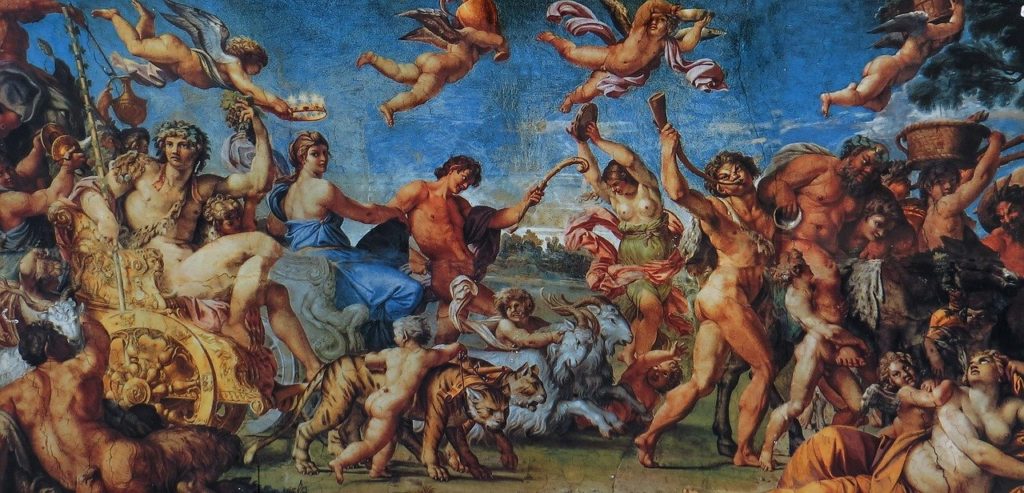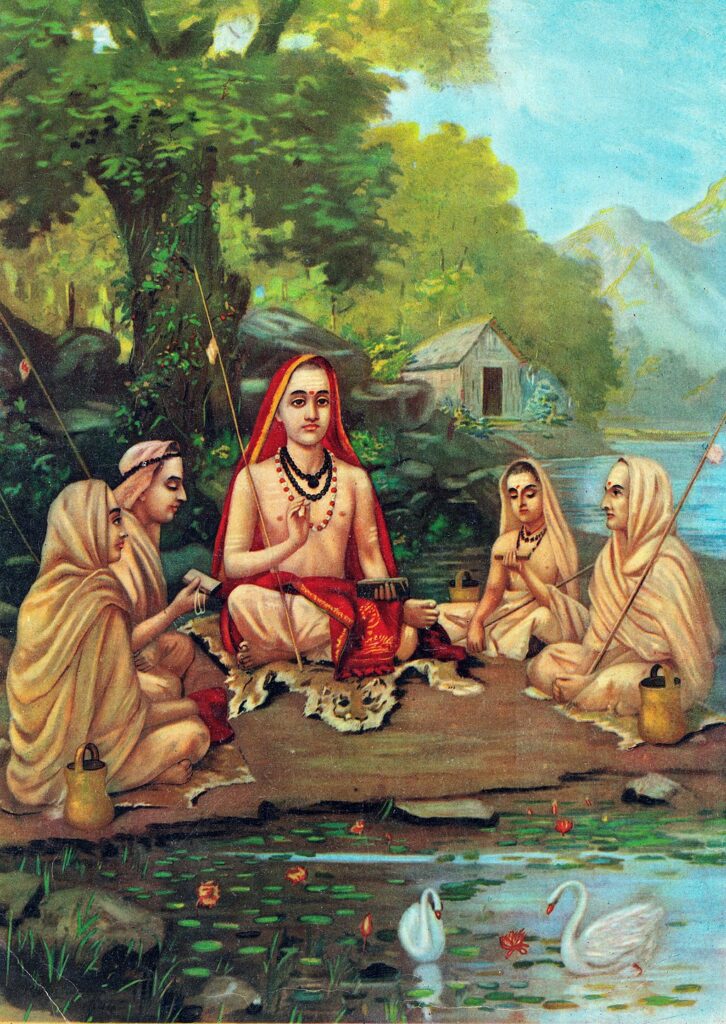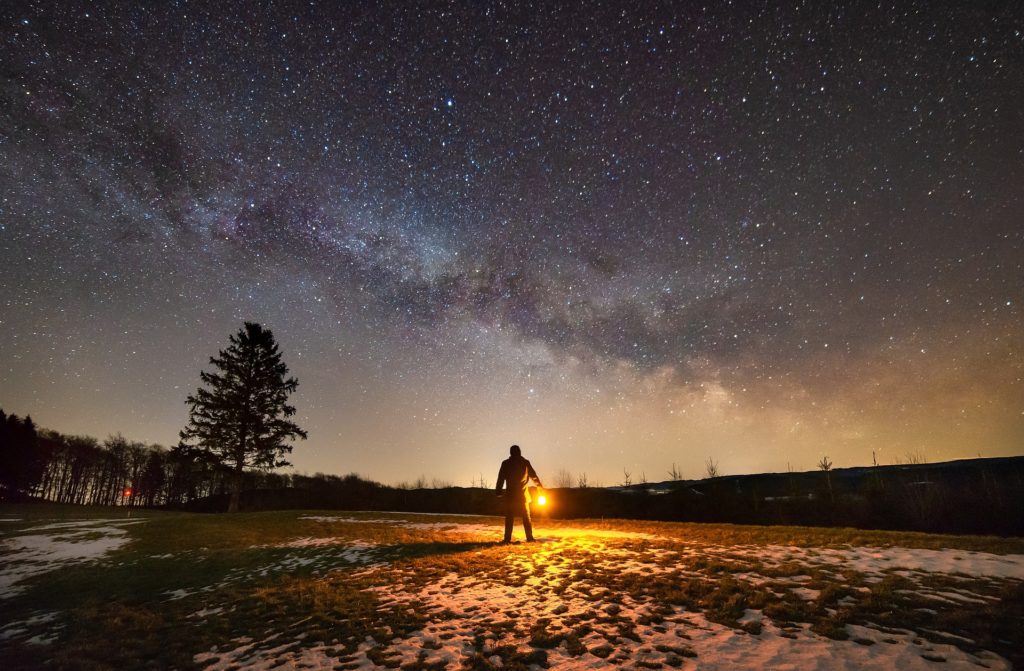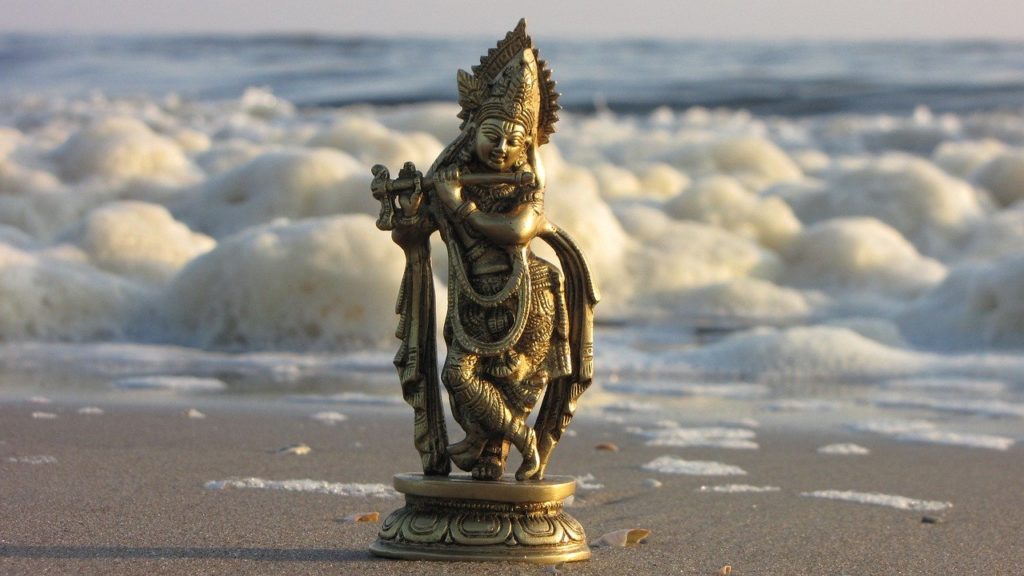
Adi Shankaracharya (Adi Shankara) was none other than the incarnation of Lord Shiva. He was born about twelve hundred years ago at a place called Kalady, situated on the banks of river Purna in Kerala. He was born to a brahmin couple – Shivaguru and Aryamba in answer to their prayers unto Sri Vadakkunnathan, a form of Lord Shiva. At the tender age of eight, Shankaracharya left his home in search of his Guru. Walking about two thousand Kilometers, he reached central India where he surrendered unto Guru Govindapada. He stayed under his tutelage for four years and attained mastery over various Vedic scriptures. From the age of twelve to sixteen Shankaracharya, on being instructed by his Guru, wrote commentaries elucidating the meanings of various scriptures (in accordance with the philosophy of Mayavada). From the age of sixteen until he passed away at thirty-two, Shankaracharya traveled across the length and breadth of India preaching the message of the Vedas.
Vedic Scriptures predict the advent of Adi Shankaracharya – Why did he preach Mayavada?
In the Shiva Purana, the Supreme Personality of Godhead, Lord Krishna, instructed Lord Shiva as follows –
dvaparadau yuge bhutva kalaya manusadisu
svagamaih kalpitais tvam ca janan mad-vimukhan kuru
–
In Kali-yuga, mislead the people by propounding imaginary meanings from the Vedas to bewilder them.
In the Padma Purana, Uttara Khanda, Chapter 236 , Lord Shiva says the following to Parvati about Adi Shankaracharya and his teachings :
mayavadam asac chastram pracchannam bauddham uchyate mayaiva kalpitam devi kalau Brahman rupina
(Padma Purana 6.236.7)
–
Translation: Mayavada or Advaita Vedanta philosophy is an impious, wicked belief and against all the conclusions of the Vedas. It is only concealed Buddhism. My dear Parvati, in this Kali-Yuga I assume the form of a Brahman (Adi Shankara) and teach this imagined Mayavada philosophy.apartham sruti-vakyanam darsayan loka-garhitam sva-karma-rupam tyajya tvam atraiva pratipadyate sarva-karma paribhrastair vaidharma tvam tad ucyate paresa-jiva-paraikyam maya tu pratipadyate
(Padma Purana 6.236.8-9)
–
Translation: This mayavada advaita philosophy preached by me deprives the words of the holy texts of their actual meaning and thus it is condemned in the world. It recommends the renunciation of one’s own duties, since those who have fallen from their duties say that the giving up of duties is religiosity. In this way, I have also falsely propounded the identity of the Supreme Lord and the individual soul.Brahmanas caparam rupam nirgunam vaksyate maya sarva-svam jagato py asya mohanartham kalu yuge
(Padma Purana 6.236.10)
–
Translation: In order to bewilder the atheists, in Kali-yuga, I describe the Supreme Personality of Godhead Lord Krishna to be without any form and without qualities.vedante tu maha-sastrera mayavadam avaidikam mayaiva vaksyate devi jagatam nasha-karanat
(Padma Purana 6.236.11)
–
Translation: Similarly, in explaining Vedanta scripture, I shall describe the same non-scriptural and inauspicious mayavada philosophy in order to mislead the entire population toward atheism by denying the personal form of my beloved Lord.
India’s condition during the time of Adi Shankaracharya :
In those days the land of India was sunk in a mire of superstitions and scriptural distortions. Degraded ritualism flourished everywhere. The essence of Sanatana Dharma, with its all-embracing message of Love and Compassion, was completely lost due to the blind performance of these rituals. It was a time when Hinduism had become suffocated with an enticing entanglement of atheistic views. Consequently, the Hindu Society came to be disunited and broken up into numerous sects each championing a different point of view. The authority and relevance of the Vedas, the very basis of Sanatana Dharma was severely maligned. Buddhism and atheism had become widely prevalent and theistic philosophies were discouraged and repressed. As a result, the true import of the Vedas was practically lost. Philosophies like Karma Mimamsa had seized importance due to which ritualistic ceremonies were practiced without an understanding of their actual purpose. The few remaining followers of Sanatana dharma wept for reform as the world needed a spiritual revolution. Adi Shankara was sent by the Supreme Lord to secure human civilization from the onslaught of atheistic influences and to lay the foundation for a Vedic revolution to flourish.

Adi Shankaracharya passed away at the early age of thirty-two. In the short span of his life, he had challenged and defeated innumerable scholars of his time. Most of them later became his followers. He influenced innumerable people and re-established the pre-eminence of Sanatana Dharma. He established four dhams at four corners of India (Sringeri, Dwarka, Badrinath, and Puri) and entrusted his four disciples to teach and propagate the philosophy of Advaita Vedanta through them. Adi Shankaracharya can be held primarily responsible for rescuing and re-establishing Hinduism at a time when the society had become infested with atheism. Apart from this, he had composed 72 devotional and meditative hymns like Soundarya Lahari, Sivananda Lahari, Maneesha Panchakam, etc. He also wrote 18 commentaries on the major scriptural texts including the Brahma Sutras, the Bhagavad Gita, and the 12 major Upanishads. He also authored 23 books on the fundamentals of the Advaita Vedanta philosophy which expounded the principles of the non-dual Brahman.
Adi Shankaracharya and the Philosophy of Advaita Vedanta (Mayavada)
The Vedic scriptures reveal that Buddha was an incarnation of Supreme Lord Vishnu and had appeared to dissuade people from their widely prevalent practice of mercilessly sacrificing animals. As people, in general, failed to understand the ultimate message of love and compassion contained in the Vedas and cited Vedic verses out of context to justify their actions, Lord Buddha had to preach against the Vedic conclusions. On the plea of Vedic sacrifice, every place was practically turned into a slaughterhouse, and animal-killing was indulged in unrestrictedly. Lord Buddha preached nonviolence, taking pity on the poor animals. Once Lord Buddha’s objective was accomplished and the tenets of Buddhism, that was contrary to the eternal truths of Sanatana Dharma, became firmly established, the Supreme Lord sent forth His dear devotee Shiva (Adi Shankaracharya) to re-establish Sanatana Dharma and reinstate people’s faith upon the Vedas.

But the philosophy preached by Adi Shankaracharya was a compromise between pure Sanatana Dharma and Buddhism (shunya-vada). One of the reasons behind this was to bewilder the atheists in Kali Yuga (as stated in the above verses from Padma Purana). The other reason was to elevate the consciousness of people gradually from atheism to the platform of pure love of God. And this gradual elevation required an intermediate philosophy that was a compromise between both. Adi Shankaracharya preached the preliminary principles of the Vedas suitable for the time being, to pave the way for pure Vaishnava acharyas to preach the science of pure devotion unto the Supreme Lord.
According to the philosophy of Advaita Vedanta (frequently referred to as mayavada), which was promoted and widely preached by Adi Shankaracharya, the material world is nothing but an illusion. The ultimate reality is Brahman which is nirguna (Attributeless) and nirakara (formless). Brahman is absolute consciousness. It is only owing to ‘Avidya’ (ignorance) or ‘Maya’ (illusion) that the Brahman appears as the Jiva, Isvara, and the world. The true nature of the Jiva (living entity) is the Brahman and attaining Brahman (liberation) is its ultimate goal. However, this is only possible by overcoming avidya. According to the Advaita Vedanta philosophy, reality or Brahman has the capability of assuming an existential form, namely the universe without undergoing any modification. Hence, the existence of the universe is relative and is not original, separate, or independent of Brahman. According to Shankara, nothing really exists apart from the Brahman. Brahman is pure Existence, Consciousness, and Bliss (Sat-cit-ananda). He is Absolute, impersonal, changeless, eternal, and all-pervading. Nature and the world around us is simply an illusion (Maya) that hides the supreme Brahman.

Maya is the cosmic illusion and the potency of Brahman, which makes the jiva experience duality. Maya is responsible for covering up the reality of absolute oneness and projecting it as though it is split up into various subjects and objects. That is why the jiva identifies itself as a limited individual when in reality it is non-different from the infinite brahman. In other words, Maya causes the jiva, which is Brahman, to forget that it is Brahman and makes it experience joys and sorrows of life and go through the cycle of births and deaths. However, Maya is no real entity and has only an apparent existence and at the moment truth is known it is dissolved. Maya is also called avidya (nescience). It is only when the jiva (living being) realizes that he is non-different from the absolute brahman that he is freed from this cycle and attains liberation. The philosophy of Advaita Vedanta can be summarized in the following sloka attributed to Adi Shankaracharya :
slok- ardhena pravakshyami yad-uktam granthakotibhih
brahma satyam jagan-mithya jivo brahmaiva naparah
–
In half of a sloka I state what has been stated by millions of texts (Scriptures) : Brahman alone is real and this jagat (material world) is mithya (false), and the jiva is non-different from Brahman.

Though Adi Shankaracharya did not invent this philosophy of Advaita Vedanta, yet he was largely responsible for promoting it widely. There are two opinions in the Advaita school of thought regarding how the jivas (living entities) come into being. They are described in brief as follows –
Pariccheda vada
It says that the jiva, though originally being the supreme Brahman, appears to be a different entity from it because of its various upadhis (false conceptions) that arise due to avidya (ignorance). It is just like the great sky (mahakasha) that appears divided by being contained in various pots (ghatakasha). This theory proposes that no real difference exists between the sky inside a pot and the sky outside. The distinction is only assumed for practical purposes. Once the pot is broken and the apparent distinction removed, the sky inside the pot and the great sky are understood to be one. Similarly, there is no difference between the embodied jiva and Brahman.
Pratibimba vada
According to pratibimba vada, when the formless, undivided Brahman is reflected upon the subtle bodies made of avidya, it appears to be many. It is just as when the sun gets reflected upon various containers of water, it appears to be many. As per this analogy, the sun remains uninfluenced by the agitation of the water on which it gets reflected, even while the reflection is influenced. Similarly, Brahman is never influenced by the changes that the jivas (living beings)undergo. Indeed, the happiness and distress of the jivas are only illusory experiences resulting from their conditioned, or reflected, state. When the jiva frees himself from illusion and achieves liberation, he reverts to his original Brahman consciousness.
Mayavada Khandana (Refuting Advaita Vedanta) – few of the many fallacies of Mayavada :
- Upadhi or Avidya can never limit the Brahman – Refuting Pariccheda vada
Lord krishna confirms in Bhagavad Gita (13.13) that the Brahman, the Supreme spirit, is beginningless, and lies beyond the cause and effect of this material world. Thus avidya cannot limit the Brahman, make it forget its identity and condemn it to ignorance. That would make avidya and these upadhis (false conceptions) more powerful than the Brahman itself.Therefore the Vedas say, agrihyo na grihyate: “The untouchable (Brahman) cannot be perceived” (Brihad-aranyaka Upanishad 9.26). Brahman being neither pierceable nor divisible, cannot be broken or delimited into jivas the way one might break a large stone into many pebbles. If that were the case then neither jiva nor the Brahman can be regarded as eternal. But the fact that jiva is eternal (anadi) is confirmed in the Bhagavad Gita (13.20).
prakritim purusham caiva
viddhy anadi ubhav api
vikarams ca gunams caiva
viddhi prakriti-sambhavan
–
Material nature and the living entities are to be understood as beginningless. Their transformations and the modes of matter are products of material nature (prakriti).
Hence the notion that individuality and uniqueness of the jiva is a mere illusion, is herein refuted.
- The movement of jiva and the movement of Brahman
Sri Baladeva Vidyabhusana states that since the jiva (living entity) moves from one location to the other, and as because jiva is considered to be indifferent to the Supreme brahman, hence it must be assumed that the brahman also moves from one place to the other along with the jiva. But Brahman’s moving from place to place is impossible, because when something moves it leaves one location and then occupies the other, where it was absent before. This is not possible since Brahman is always present everywhere.
On the other hand if it is assumed that the Brahman does not move along with the jiva, then it must be concluded that the upadhis (false conceptions) constantly delimit new portions of the brahman as the jiva relocates from one place to the other and simultaneously they release the previously delimited portions. This proposition also subjugates Brahman and makes it a toy in the hands of the upadhis, which contradicts the supreme position of the Brahman.If however one argues that the whole of the brahman is grasped by the upadhis, then it must be concluded that Brahman is not free from upadhis. This implies that there can be no liberation for the living entity as it can never be free from avidya and upadhis.

- Refuting Pratibimba vada
Srila Jiva Goswami states that Brahman can cast no reflections upon the subtle bodies of avidya as brahman is formless and devoid of all attributes. Only something that possesses attributes like form or color can cast its reflection – something which is impossible for invisible objects. Likewise, the brahman cannot cast its reflection upon anything.If one compares the Brahman to the sky and argues that the sky can cast its reflection upon water, then it needs to be clarified that it is not the sky but instead the stars and the planets that cast its reflections. If the sky could cast a reflection, then the wind would also be able to cast one, because air is a more gross material element than sky.If one talks of the bluish hue visible in the sky then it must be stated that according to modern science, the bluish background seen behind the visible bodies in the firmament is an optical illusion created by the refracted sunlight passing through the atmosphere. No concrete, underlying object is there to cast a reflection, only the invisible firmament. Hence the analogy comparing Brahman to the sky being reflected in water is inappropriate here.
- Brahman and Avidya cannot co-exist
How is it possible for Brahman which is indivisible and of pure consciousness to have portions that become subjugated by Maya (avidya) and thus become fragmented into jivas? Just as light and darkness cannot coexist, similarly absolute knowledge and ignorance (avidya) cannot co-exist.
This outcome is only possible if either Brahman degrades itself to Maya’s empirical level or else if Maya elevates herself to the absolute plane of Brahman so that she could influence it. The degradation of Brahman is impossible as Brahman is unchangeable and without any attributes. On the other hand, if Maya elevates herself to the level of Brahaman, then it would amount to duality on the plane of absolute reality as both of them will then have equal status. This contradicts the very basic principle of Advaita monism. In other words, Brahman cannot be influenced and subjugated by Avidya, as per the tenets of Advaita Vedanta. Hence they cannot explain how the jivas come into existence.
- Srila Vyasadeva’s experience does not support the theory of Advaita Monism
The verses of Srimad Bhagavatam describe the Supreme Personality of Godhead Sri Krishna along with His internal potencies, His marginal potency (the jivas), and His external potency (Maya). Vyasa did not see a non-differentiated Brahman being overpowered by Maya and turning into many jivas. Rather, He saw that the jivas are distinct from the Supreme Lord and are captivated by Maya because they think themselves independent of the Supreme Lord. Vyasadeva thus discovered that the cause of the jivas’ suffering and their material predicament is their sense of false independence. At the same time, He saw that the solution to the jivas’ predicament is rendering devotional service unto the Supreme Person (bhakti-yogam adhoksaje), as opposed to magining a state of oneness with Him.
The conclusions of the Vedic scriptures are opposed to the philosophy of Advaita Vedanta – Explained briefly
In fact if we study the vedic scriptures sincerely, we shall realize that the individual jiva and the Brahman are eternally distinct conscious beings
‘nityo nityanam, cetanas cetananam’ – ‘Bhagawan is the supreme eternal amongst all other eternal beings. He is the fundamental conscious being among all the other conscious beings’.
Both the Brahman and the jiva are distinct from matter. The jiva is one of various energies of the Supreme Brahman. Brahman is the bodily effulgence of the Supreme Lord who is the reservoir of unlimited transcendental qualities. The jiva is the eternal servitor of the Supreme Lord and can never be equal to Him. The perfection of the jiva’s existence and its salvation lies in rendering loving devotional service unto the Supreme Lord, who is the cause of all causes. This is the essence of all Vedic scriptures. The below verse from Bhagavata Purana confirms this statement –
suta uvaca
atmaramas ca munayo
nirgrantha apy urukrame
kurvanty ahaitukim bhaktim
ittham-bhuta-guno harih
(Srimad Bhagavatam 1.7.10)
–
Suta Gosvami said: All different varieties of atmaramas [those who take pleasure in the atma, or spirit self], especially those established on the path of self-realization, though they are freed from all kinds of material bondage, desire to render unalloyed devotional service unto the Supreme Personality of Godhead. This implies that the Supreme Lord possesses transcendental qualities and therefore can attract everyone, including liberated souls.

